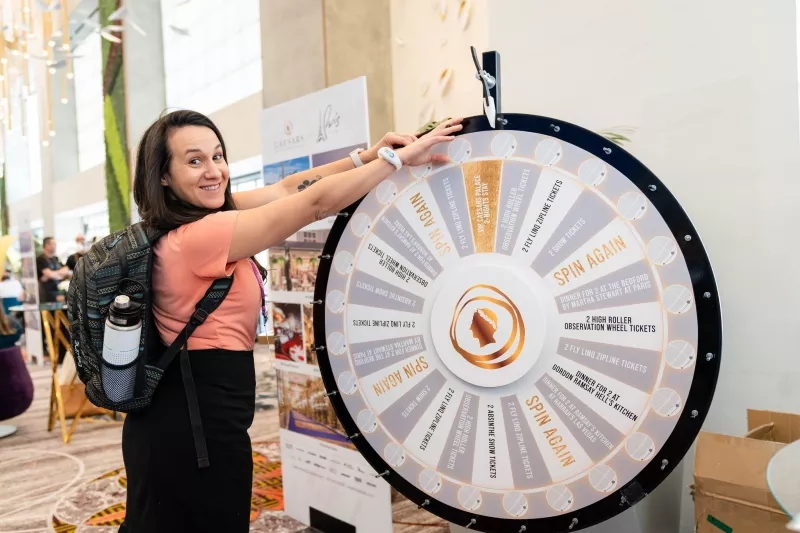From small internal meetings to immense trade shows, events are increasingly being planned with the help of event technology. In fact, a recent Northstar/Cvent Meetings Industry PULSE Report found that 42% of event planners allocated more funds to event tech than in 2023.
Why? Event tech not only makes it easier to manage events, but it also allows organizations to collect and track data that proves the overall success of their events.
Event managers must track a wide range of data points to prove event ROI, and ensuring this data is collected and aggregated into a single, easy-to-interpret post-event report makes determining ROI–and how to approach future events–faster and easier.
What Is a Post-Event Report?
A post-event report is a collection and summation of all the data stakeholders need to determine an event’s ROI, whether the event met its expected goals/KPIs, and where improvements might be needed for next time.
It’s your job, as an event planner and as the owner of the post-event report, to use the report to present your event data in as clear a manner as possible.
Why Are Post-Event Reports Critical for Event Planners?
Having all the data is one thing, but making sure it’s organized in a logical and digestible manner is truly what’s essential for presenting the success of an event to your organization’s decision-makers. A well-organized and designed report is also an effective tool for engaging sponsors and exhibitors for future events. As such, a good post-event report should always be included as a task at the end of your event checklist.
You will have some stakeholders who are all about the numbers; they love getting into the nitty-gritty of things and drawing their own conclusions about abstract figures. A post-event report is your opportunity to present these stakeholders with the most important data.
More often, though, stakeholders appreciate a clear, attractive, and well-summarized account of things without having to sift through raw data. It is here that a post-event report will really shine and take your presentation of an event to the next level with graphs, tables, and other visual elements.
With a post-event report in hand, stakeholders can clearly see what worked and what didn’t, allowing for the creation of a data-driven event planning strategy for future events.
How to Create a Post-Event Report
To begin creating a post-event report, you’ll want to gather all your data. Ideally, this data has been collected throughout the life of your event on your event management software, allowing you to seamlessly pull it all together.
As a planner, you’ll need to know what information your company’s stakeholders require to make decisions and what sponsors and exhibitors will need to know before and after participating in your event.
After your event concludes, that same event tech can be used to draft a post-event report that’s accurate, thorough, and easy to navigate. The best part is that once you establish a format that works, you can use it as a plug-and-play template to document future events.
It is worth repeating that an effective post-event report is visual and eye-catching. So, as much as you can, present the data you’ve collected with graphs, tables, photos, and other visual elements, rather than dense blocks of text or raw data.
What to Include in a Post-Event Report
An effective post-event report walks stakeholders through your event’s key data points and offers a clear-cut analysis of its success or areas where improvements can be made. Start by breaking things down into digestible sections.
1. Event Summary
This section summarizes what stakeholders can expect to see illustrated throughout the rest of the report. Here, you should provide a brief overview of the event itself and its major goals and KPIs. Then, offer an analysis of whether or not those KPIs were met, key successes, and any recommendations for improvement and tweaks to your future event strategy.
At this stage, you’re simply offering a brief overview before diving into the data. From here, your post-event report will elaborate on your conclusions.
2. Marketing Efforts
What did you and your marketing team do to encourage attendance and attract sponsors and exhibitors? What kind of media exposure did you get? Here, you should reference your engagement efforts and highlight the ones that worked best, such as:
- Social media (channels used, frequency of posts, content with the most views/engagement, engagement with #hashtags)
- Email lists
- Paid ads
- SEO efforts to boost organic search traffic
- Press releases
- Cross-posted content across sponsors’ and exhibitors’ marketing channels
- Cross-posted content across personal social media pages
- Free swag or other incentives for attendance
- Early bird pricing or other registration discounts
3. Logistics
Discuss the who, what, when, how, and why of planning this event. Analyze your chosen venue and whether or not it really was the best option for the event type and size. Any issues with transportation? Accommodations? Staffing? Adequate Wi-Fi?
4. Attendance and Registration
Here, you want to illustrate not only the number of people that attended compared to your registration numbers but also the demographics of your attendees. This can help you pinpoint exactly to whom your event appeals most and whether the final data matches your expectations.
- Attendee Numbers: Capture overall attendance as well as rates of high traffic and low traffic for different dates or sessions.
- Registration Numbers: Your total attendance numbers should be compared to your registration data to determine your attrition rate (how many registrants were no-shows). What’s more, break down your registration as much as possible to understand when you received the most registrations. Was it during a sale on registration? Was it after a big promotional campaign went live? For many events, the final days leading up to an event are often the most popular registration days.
- Demographics: Document where attendees are from, their age, race, gender, industry, company, etc.
- Attendee Feedback: Beyond the numbers, what did attendees think about the event? Post-event survey feedback is invaluable when it comes to improving your future events.
5. Sponsor/Exhibitor Data
Show what sessions, demonstrations, or exhibit booths were the most or least popular, and offer some analysis on why you think this was so. This would also be a good section to include sponsor and exhibitor feedback:
- How was foot traffic?
- Were there a satisfactory number of quality leads?
- Ease of booth set-up/breakdown?
- For speakers, were audiences adequate and engaged?
6. Budget Breakdown
This section shows event monetization after accounting for costs. First, provide an itemized list of all the costs associated with the event. Then, compare that with revenue gained through ticket sales, exhibitor and sponsor fees, new business bookings, etc. Conclude this section by sharing whether the event’s financials landed in the red or, hopefully, the black.
7. ROI Summary
Event ROI often leans toward the financial, but there could be other intangibles that your stakeholders might think offset hard cash—especially depending on your event’s goals. These ROI considerations might include how many leads were generated, whether meaningful connections were made between businesses or attendees, how much content was created for future marketing materials, how many sponsors or exhibitors achieved their goals, etc.
If you have the data to do so, figure out if your company’s brand got a boost in the eyes of the public and/or your industry peers. Then, keeping all that in mind, it’s time to answer the big questions:
- Overall, was this event successful?
- Should this event or similar events be repeated in the future?
Post-Event Report Example
The following is a brief example of a post-event report, in this case for a regional home and garden show:
Event Summary
Held a 3-day home and garden show in the local convention center. 200 vendors met with 20,000 attendees. Overall, a successful, well-received event that could be planned annually based on all feedback and ROI. Consider selecting a different venue for future events based on difficulties experienced onsite.
Marketing Efforts & Public Engagement
- Weekly posts on Facebook and X; ramped up to daily two weeks before the event.
- Targeted email campaigns based on lead nurture lists, registration types, and interests selected during registration.
- Press releases shared across company social media channels.
- Canned social media copy created for exhibitors, shared across 110 exhibitors’ social media channels and 10 sponsors’ social media channels.
- Pre-event social media games engaged 50 people online.
- More than 70 uses of event #hashtag across external social media channels.
Logistics
Mostly smooth, but some jamming for exhibitors when setting up. The air conditioning broke down on day one but was fixed within three hours. Some complaints about limited Wi-Fi. Recommend scheduling longer setup time with set load-in and load-out times for exhibitors.
Attendance and Registration
- Attendee Numbers: 20,000 attendees over the course of three days. Most traffic on Saturday.
- Registration Numbers: 24,000 registrants = 17% attrition rate. Majority of registrations occurred within three weeks of the event. 10% of registrations occurred onsite.
- Demographics: Attendees were primarily aged 45-65 (72%). Attendees were also largely female (68%). 30% attended as a representative of their organization, with building business relationships as their primary reason for attending.
- Attendee Feedback: Attendees were overall satisfied with the event, with 75% stating they would likely or certainly attend the event annually. The most common concerns for attendees were the broken AC and inconsistent Wi-Fi. This particularly affected exhibitors and vendors, who rely on Wi-Fi for presentation materials and monetary transactions.
Sponsor/Exhibitor Data
On average, exhibitors interacted with 500 or more attendees per day. Many exhibitors are confident in long-term lead captures, and many attendees praised the plant nursery booths.
Budget Breakdown
Expenses: rental of convention center space, facilities management, security, event tech.
Revenue: ticket sales, concessions, sponsor and exhibitor fees. After expenses, our company earned $100,000 in revenue.
ROI Summary
Excellent revenue intake. Happy exhibitors and attendees who say they would be happy to participate again. Conclusion: great return on investment.
Frequently Asked Questions
Looking for a bit more information about post-event reports? Look no further! Check out these additional FAQs:
What Is a Post-Event Review?
A post-event review is the formal sharing of a post-event report with stakeholders, where you will present your report, discuss the results with stakeholders, and make strategic decisions together about future events.
How Do You Write a Good Report After an Event?
A good post-event report is one that is thorough and includes the data your stakeholders and vendors need to understand how successful your event was. The report presents that data in a clear, visually attractive way. To get all the data you need and the formatting you desire, the use of event management software and its integrated event reporting functionality can make the process much smoother than trying to do it on your own from scratch.
How Do I Recap an Event?
When you recap an event, you are essentially giving a high-level summary of that event. You want your summary to give stakeholders a good picture of what went on without focusing too much on superfluous details or other information irrelevant to the perception of the event’s overall performance.
Can I Get Help Creating a Post-Event Report?
As the source of record for your event, a post-event report is one of the most important documents you will create. Fortunately, you don’t have to do it alone. Specialized and customizable event management software and the customer support experts behind it can help you learn more about how to leverage event reporting tools to create post-event reports.










